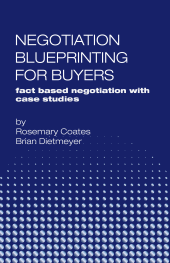
Put yourself in this scenario – you wake up every day for a week feeling unwell, well below par. You don’t have any broken bones, or spots, or bruises; you have no visible signs of an illness or injury. You just don’t feel well. Eventually you go to the doctor, wait patiently in the doctor’s waiting area, and when it is your turn, take a seat in the doctor’s consulting room.
How would you then feel if the doctor does not talk to you about the reason for your visit? She (or he) just immediately starts to write a prescription for you. Rationally we know that this is not the right way to proceed.
Yet, when applied in a business context, often salespeople jump immediately to ‘writing the prescription’ before diagnosing and confirming the problem with the customer.
Taking time to think about the criteria a customer will use when making a decision needs to be the first step in your sales process, after qualifying an opportunity.
In fact, it is even more effective to consider, from the buyer perspective, what they would do if they do NOT do a deal with you. If they do not come to an agreement with you, would they go to one of your competitors? Or do it themselves? Or perhaps do nothing at all? Please do not misunderstand – I am not saying that the customer will not do a deal with you. Just consider what they would do IF they do not come to a deal with you.
In working to understand what the customer would do if they do not do a deal with you, you are actually revealing your ‘real’ competitor in the deal. Every time you make an offer, the customer will compare your offer to their preferred alternative to doing a deal with you.
Once you believe you know the customer’s preferred alternative to doing a deal with you, still thinking from the customer perspective, consider the impact to the customer. Lower cost? Ease of integration? Faster time to market? Low risk? Quicker ROI? These customer impacts are in fact the customer’s decision criteria (also known as their success criteria). Now you can change the conversation with the customer by focusing on their decision criteria. And what a good way to continue to build your credibility. Help the customer understand that you have been considering the business from their perspective. Share the list of decision criteria. Ask if any criteria should be removed? Are there any criteria missing? If so, add them.
Next, prioritize the decision criteria, again doing this from the customer perspective. Then consider how well your solution addresses each individual customer decision criteria compared to the customer’s preferred alternative. Does your solution address each individual customer decision criteria better than / equal to / or not as well as their preferred alternative to doing a deal with you.
Where your solution helps to address the high priority customer decision criteria better than their preferred alternative you have uncovered an important differentiator. Your solution can help the customer address (or achieve) a criteria that is highly important to them, better than their preferred alternative. Make sure you share this with the customer as early in the lifecycle of the deal as you can, and remind them often.
Where your solution cannot address the high priority customer decision criteria as well as their preferred alternative, you have just identified key areas of risk for you. You are vulnerable in these high priority areas. As early in the lifecycle of the deal as you can, work to mitigate the impact of these areas of vulnerability.
In doing the analysis above, known as the Consequences of No Agreement analysis (CNA), you have identified ways to change the conversation with your customer; you have identified your true competitor; you have uncovered and prioritized customer decision criteria for the deal; and have revealed your points of differentiation associated with criteria that is of highest importance to the customer; and exposed your deal risks or vulnerabilities.
Now you are in a position to think about your 'prescription' for this customer.





